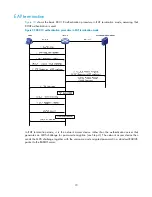
80
Configuring the quiet timer
The quiet timer enables the network access device to wait a period of time before it can process any
authentication request from a client that has failed an 802.1X authentication.
You can set the quiet timer to a high value in a vulnerable network or a low value for quicker
authentication response.
To configure the quiet timer:
To do…
Use the command…
Remarks
1.
Enter system view.
system-view
—
2.
Enable the quiet timer.
dot1x quiet-period
Required.
Disabled by default.
3.
Set the quiet timer.
dot1x timer quiet-period
quiet-
period-value
Optional
The default is 60 seconds.
Enabling the periodic online user re-authentication function
Periodic online user re-authentication tracks the connection status of online users and updates the
authorization attributes assigned by the server, such as the ACL, VLAN, and user profile-based QoS. The
re-authentication interval is user configurable.
To enable the periodic online user re-authentication function:
To do…
Use the command…
Remarks
1.
Enter system view.
system-view
—
2.
Set the periodic re-
authentication timer.
dot1x timer reauth-period
reauth-
period-value
Optional.
The default is 3600 seconds.
3.
Enter Ethernet interface view.
interface
interface-type interface-
number
—
4.
Enable periodic online user
re-authentication.
dot1x re-authenticate
Required.
Disabled by default.
The periodic online user re-authentication timer can also be set by the authentication server in the
session-timeout attribute. The server-assigned timer overrides the timer setting on the access device and
enables periodic online user re-authentication, even if the function is not configured. Support for the
server assignment of re-authentication timer and the re-authentication timer configuration on the server
vary with servers.
The VLAN assignment status must be consistent before and after re-authentication. If the authentication
server has assigned a VLAN before re-authentication, it must also assign a VLAN at re-authentication. If
the authentication server has assigned no VLAN before re-authentication, it must not assign one at re-
authentication. Violation of either rule can cause the user to be logged off. The VLANs assigned to an
online user before and after re-authentication can be the same or different.
















































